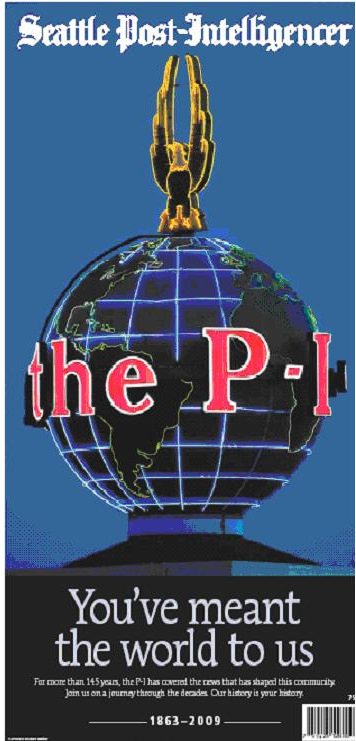 Clay Shirky takes us back 500 years to reflect on the revolution that’s going on right now. Everyone who wonders “What will become of journalism when newspapers are gone?” should read this superbly voiced essay by the author of Here Comes Everybody. The piece has racked up 225 comments and trackbacks just over the weekend, and there will be many more.
Clay Shirky takes us back 500 years to reflect on the revolution that’s going on right now. Everyone who wonders “What will become of journalism when newspapers are gone?” should read this superbly voiced essay by the author of Here Comes Everybody. The piece has racked up 225 comments and trackbacks just over the weekend, and there will be many more.
To sum up Shirky’s case: The game is over for newspapers. Nothing can save the business, so it’s pointless to try. We’re in the middle of a revolution and revolutions are uncomfortable things because “The old stuff gets broken faster than the new stuff is put in its place.”
His distant mirror is 16th century Europe, when the printing press was beginning to lift the world out of the Dark Ages. As translations of the Bible into languages other than English began to threaten the church-dominated world order, everyone frantically searched for assurance that the old institutions would be preserved. This applied even to disrupters like Martin Luther, who insisted he wasn’t creating a schism in the church even as he was inventing Protestantism.
“And so it is today,” says Shirky, fast-forwarding. “When someone demands to know how we are going to replace newspapers, they are really demanding to be told that we are not living through a revolution…They are demanding to be lied to.”
Revolutions are messy things because old institutions have to be destroyed before new ones are put in place. We’re witnessing the destruction now but we have no idea what will grow out of the rubble. And that’s scary. “The list of models that are obviously working today, like Consumer Reports and NPR, like ProPublica and WikiLeaks, can’t be expanded to cover any general case, but then nothing is going to cover the general case,” Shirky writes. The only certainty is that the newcomers will be more specialized, distributed and democratized than the old, vertically integrated institutions.
We won’t say Clay Shirky puts our minds at ease, but he at least points out that we have come this way before and that everything turned out pretty well in the long run. All we have at this point is faith and optimism. The sooner we can turn our attention from salvaging the unsalvageable to inventing the future, the sooner we can get on with the rebuilding.
Eugene (Ore.) Register-Guard columnist Bob Welch should read Shirky’s essay. So should Mark Willes, former publisher of the Los Angeles Times and now head of Deseret Management Corp., who’s quoted in this Salt Lake Tribune story remarking “[I]f we’re going to have all the things I think are central to having a civilized society and a successful society, [newspapers] must grow.”
Their collective backs against the wall, members of the Northern California Media Workers Guild voted 10-1 to give the San Francisco Chronicle broad authority to lay off employees without regards to seniority as well as to cut vacation time and extend working hours. The union, which represents 483 employees at the Chron, had little choice. Owner Hearst Corp. has threatened to close the entire operation without major concessions. Even so, Hearst is still likely to lay off 150 Guild workers.
Union members took consolation in the fact that that figure is one-third less than the 225 jobs Hearst originally threatened to eliminate. The Guild was also able to secure a decent severance package for laid-off employees. However, members will pay more for health benefits, lose 25% of their vacation and work longer hours. The Mercury News story notes that Hearst had threatened to make “most” of the 225 threatened job cuts in the Chron‘s 260-person newsroom. This seems incredible, since a cutback of that magnitude would leave less than 200 reporters covering the entire Bay Area. That may still be the case after the anticipated layoffs happen. Hearst is also eliminating 100 unionized pressroom jobs after it outsources printing to a Canadian contractor in June.
How to Save the Classified Advertising Business
 Christopher Ryan and Steve Outing propose some head-slappingly simple ideas in their “Classifieds Manifesto.” So why aren’t more newspaper companies following them?
Christopher Ryan and Steve Outing propose some head-slappingly simple ideas in their “Classifieds Manifesto.” So why aren’t more newspaper companies following them?
Newspapers can still have important and profitable classified advertising businesses, the authors say, but first they have to stop thinking about classifieds as agate type on a page. Craigslist has won that battle, so newspapers have to change the rules of the game.
Why not open a used-car lot for your auto clients? Or create a division that helps realtors sell homes? And while you’re at it, reinvent the way you present information. Craigslist is butt-ugly, man. Use tables and icons and easily navigable ways to get readers to the stuff they want to buy. And while you’re at it, get a video camera out to those properties that realtors are trying to sell and give them a hand.
There are a bunch of other smart and simple ideas in this essay. Send the URL to the head of your classified advertising group.
Miscellany
Mark Potts totes up the market capitalizations of the publicly held newspaper companies in the US and comes to a striking conclusion: Their combined value is just $1.3 billion, or a little more than what The New York Times Co. paid for the Boston Globe alone ($1.1 billion ) in 1993. This same group of companies was worth over $7 billion just six months ago. And speaking of the Globe, Potts says Barclays recently valued the paper at just $20 million.
McClatchy Watch is reporting that the Kansas City Star could announce a layoff early this week that’s larger than the newspaper’s last three layoffs combined. This rumor is a little confusing, however, since the Star announced plans to cut 15% of its workforce just last week.
Owners of the Minneapolis Star Tribune and its pressmen’s union have reached agreement on a set of union concessions involving layoffs, wage cuts, health care premium increases and staffing reductions. No details were released pending a vote by members on the agreement this week.
McClatchy Watch is reporting that the Kansas City Star could announce a layoff early this week that’s larger than the newspaper’s last three layoffs combined. This rumor is a little confusing, however, since the Star announced plans to cut 15% of its workforce just last week.
 The Ann Arbor News, a newspaper that has served the Michigan city since 1835, will cease daily operations in July. The newspaper’s “business model is not sustainable,” said publisher Laurel Champion in a statement this morning. The paper will scale back to twice-weekly print frequency and move the bulk of its newsgathering operations online.
The Ann Arbor News, a newspaper that has served the Michigan city since 1835, will cease daily operations in July. The newspaper’s “business model is not sustainable,” said publisher Laurel Champion in a statement this morning. The paper will scale back to twice-weekly print frequency and move the bulk of its newsgathering operations online.

 Today is Newspaper Death Watch’s second birthday (you can
Today is Newspaper Death Watch’s second birthday (you can 









